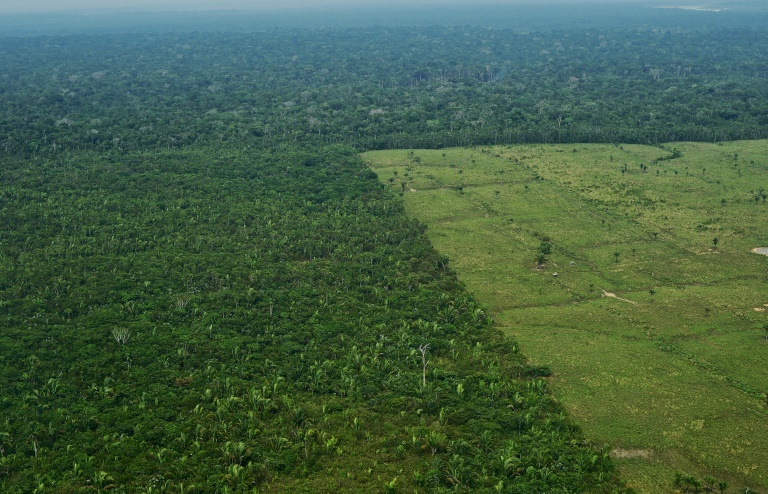PICTURES: SANDF capability demonstration at Rand Show
In western Brazil's Amazon, the very people tasked with looking after the world's greatest rainforest are themselves wondering if they have a future.
“We are just trying to survive,” said Cleyton de Oliveira, 24.
De Oliveira lives in one of the special areas called extractive reserves that were pioneered in the 1980s by environmentalist and union leader Francisco “Chico” Mendes as a way of putting small producers in charge of the forest.
The idea was to allow modest communities to farm in a sustainable manner. That way the poor had an opportunity to make a living and to own land, while their presence would keep the giant ranches and plantations encroaching constantly on the Amazon at bay.
Mendes was murdered by a rancher in 1988 but not before his groundbreaking idea had taken root, part of a legacy that made him a national hero.
Three decades later, there are 90 such reserves across Brazil, covering 96,500 square miles (250,000 km2), including two created in 2008 in the western state of Amazonas, called Ituxi and Medio Purus — huge territories home to just 6,600 people in total.
They are the descendants of workers employed in slavery-like conditions as rubber tappers in the 20th century before extractive reserves gave the poor a chance to build new, freer futures.
“We had to fight for years to get them, getting a lot of threats,” said Silverio Barros Maciel, an Ituxi reserve community leader.
But today, with almost no government support and ever growing pressure from ranchers who want their lands, the forest farmers say that clock is turning back.
– Guardians of the Amazon –

Aerial view of deforestation in the Western Amazon region of Brazil
In the two Amazonas reserves, farmers harvest Brazil nuts, acai, fish and other produce on a modest scale. The creation of the reserves “meant freedom,” says Medio Purus leader Jose Maria de Oliveira.
It also meant another line of defense for the Amazon rainforest, putting locals in charge of making sure that exploitation of the natural resources is sustainable and preventing big companies from grabbing land.
Jose Maria de Oliveira credits the creation of the two reserves for saving species like the arapaima, a mammoth fish — one of the biggest river fish in the world — from annihilation.
But the forces pressing down on the rainforest are ever stronger. The highest deforestation rates in Brazil are found in the area of Labrea, the regional center which governs both reserves and which is a center for logging and ranching.
“There’s a whole mosaic of conservation areas here but that’s not enough to halt the deforestation because there are people who want it to go ahead,” Jose Maria de Oliveira said.
At the government environmental body named after the slain campaigner — the ICMBio or Chico Mendes Conservation and Biodiversity Institute — officials feel powerless.
There are just four employees to monitor conservation in an area about the size of one and a half Puerto Ricos. “We are struggling to keep the forest going but we see that conservation of the Amazon is not the government’s priority,” Joedson Quintino, the ICMBio representative for Ituxi said.
– Abandoned –
Simply living on the extractive reserves is tough. What farmers say is the government’s near abandonment of their communities makes it tougher.
There are no roads, so everything and everybody must travel by river.
To get from Labrea to Ituxi takes six hours in a fast boat, using up $140 worth of fuel each way. In winter months, when the heavy rains come, boats can take shortcuts, cutting the journey in half.
Felipe Spina Avino, World Wildlife Fund (WWF) forestry conservation analyst, uses drones to map an area of rainforest in the Ituxi reserve in the Western Amazon region
Scarce educational facilities make raising a family harder. In Ituxi, for example, there is only basic schooling and the teacher, Francisco da Silva, lives in the small wooden building.
He has used his ingenuity to build a solar system powering a television, printer and music player used during classes. Others rely on noisy, expensive-to-run generators.
“Life on the riverbanks is hard,” says Sicleudo Batista, another rural teacher who at 29 has already had malaria six times.
In Medio Purus there are around a dozen schools for middle school, with satellite links for distance learning, but there’s no access to higher education, which makes it hard to persuade young people not to leave the reserve. There are a dozen other primary school facilities, all in simple hits with just a handful of rooms, including for where the teacher lives.
Cleyton de Oliveira is the only health worker for all of Ituxi and half of his monthly $400 salary goes on boat fuel costs. There are no pharmacies or dedicated boat ambulances, while a boat dispensing preventative care has visited Medio Purus just once so far this year and not at all in Ituxi.
It’s meant to visit both twice a year.
The mayor of Labrea, Gean Barros, can offer little help. From the same center-right party as President Michel Temer, a big supporter of agribusiness, Barros opposed the creation of the two local extractive reserves.
Residents accuse him of doing everything he can to weaken the reserves.
He blames the lack of help given to them on the central government. “Ninety percent of what they promised was not carried out,” he said.
Ituxi leader Francini dos Santos said there’s no other choice but to keep trying — neither for them nor for the forest.
“There are so many obstacles that we get tired,” he said. “But if we abandon it, everything will get worse.”
Download our app